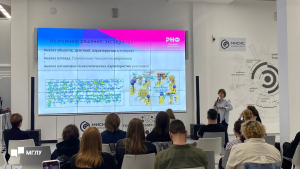On Friday 27 September, the All-Russian Course of lectures ‘10 Years with the Russian Science Foundation’ came to an end.
Young scientists of MSLU, researches of the SCoDis Centre, told about their works within the framework of projects supported by grants of the Russian Science Foundation.
The event was opened by Olga Kamaludinovna Iriskhanova, Vice-Rector for Science, Doctor of Philological Sciences, Professor and Head of Grant Projects, as well as Director of the SCoDis Centre.
‘What Russian scientist doesn’t dream of permanent support from the Russian Science Foundation (RNF)? This is, of course, a rhetorical question – every Russian scientist, young or experienced, dreams of having his or her research recognised and supported. The task of the RNF is to search for young talents, famous scientists and support the most interesting, most significant projects for our country. This can be a variety of support, up to the point where the RNF encourages scientists to assemble their own teams, to take on undergraduate and postgraduate students in research groups.
We are proud that in fact today we are celebrating the same anniversary as the RNF. 10 years of grant projects at MSLU, 10 research areas and even more projects, more than 168 million rubles. Many projects at MSLU are projects with an international component, and foreign scientists have been heading our projects and are still actively involved in them. This year we started a research project on gestures and polymodal communication, in which our Brazilian colleagues are now very actively involved.
Lectures by SCoDis employees, which were presented in the framework of the lecture course:
‘MULTICOR Oculomotor Reaction Corpus: RESEARCHING THE PERCEPTION OF TEXT AND PICTURE’, RNF project 22-28-01754 “Research on saving human cognitive resources when interpreting media texts: Development of Multimodal Oculographic Reaction Corpus MultiCOR”, project leader Kiose Maria Ivanovna, Doctor of Philological Sciences, Professor.
Maria Kiose, Doctor of Philology, Chief Researcher of the Centre for Sociocognitive Discourse Studies at MSLU, Leading Researcher of the Laboratory of Multichannel Communication at the Institute of Linguistics of the Russian Academy of Sciences, told about the creation of the MultiCOR Corpus of Oculomotor Behaviour, which includes the results of the study of text and image perception: people with a higher verbal index are less distracted by focusing effects to attract attention, while the duration of fixations in text areas is longer, since the duration of fixations in text areas is longer. The created corpus will help to predict the influence of information on human perception, help web-developers to design applications and sites with given parameters for users, and also this corpus can be used for practical training of students when teaching multimodal analysis.
‘HOW TRANSLATORS SPEAK AND MOVE DURING SIMULTANEOUS INTERPRETATION THAT THEY DON’T GET HEATED?’, RNF project 19-18-00357 “Verbal and bodily behaviour of a speaker under conditions of increased cognitive load: analysis of speech, gestures and eye movements”, project leader Olga Kamaludinovna Iriskhanova, Doctor of Philological Sciences, Professor, Director of the Centre for Sociocognitive Discourse Studies at Moscow State Linguistic University (SCoDis).
Leontieva Anna Vasilievna, Ph.D. in Philology, Senior Researcher at the Centre for Sociocognitive Discourse Studies at MSLU (SCoDis), Junior Researcher at the Laboratory of Multichannel Communication of the Institute of Linguistics of the Russian Academy of Sciences and Agafonova Olga Vladimirovna, junior researcher of the Centre for Sociocognitive Discourse Studies at MSLU (SCoDis), junior researcher of the Laboratory of Multichannel Communication at the Institute of Linguistics of the Russian Academy of Sciences, spoke about the cognitive load of simultaneous interpreters and how gesture behaviour helps them cope with it: in moments of difficulty, interpreters predominantly use gestures with an adaptation function and a pragmatic function; they concentrate on the visual stimulus, which becomes a source of kinetic information for them and facilitates the alignment of viewpoints with the speaker; and some interesting features of the relationship between the interpreter’s psychotype and the frequency of using certain gestures were discovered: for example, emotionally stable interpreters are inclined to frequently copy representational gestures.
Watch the broadcast of the MSLU Lecture ‘10 years with the RNF’
More news about science at MSLU: https://science.linguanet.ru/
Russian Science Foundation: https://rscf.ru/



